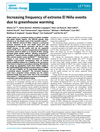-
Disaster Risk Reduction Important to Preserve Development Gains, El Niño May Becoming More Frequent, Powerful
April 24, 2014 By Donald BorensteinAs climate change threatens more extreme weather, it is becoming more important to incorporate disaster risk reduction into poverty-reduction efforts, writes the Overseas Development Institute in a new report. The authors of The Geography of Poverty, Disasters, and Climate Extremes in 2030 argue that the hard-won gains of development are threatened by vulnerability among the poorest to climate change disasters, especially droughts. “Up to 325 million extremely poor people will be living in the 49 most hazard-prone countries in 2030, the majority in South Asia and sub-Saharan Africa,” write Andrew Shepherd et al. Using an index measuring the risk of a nation’s exposure to natural disasters as compared with a nation’s vulnerability to extreme poverty (income less than $1 daily), the report singles out 11 nations at high risk in both categories. “Over the last 20 years, the countries highlighted in this report as being at greatest threat of disaster-induced impoverishment in 2030 have seen an average of just $2 million…spent on reducing disaster risk each year.” Disaster risk management programs can make a difference, the authors write. “Eleven percent of those exposed to the [2010] Haiti earthquake lost their lives,” while only one-tenth of a percent of those exposed to the comparably sized 2008 Chile earthquake died. The difference, the report claims, was preparedness.
A recent Nature Climate Change study offers evidence that El Niño, a naturally occurring shift in climate caused by ocean temperature changes in the Pacific, may be increasing in frequency and intensity. “With a projected large increase in extreme El Niño occurrences,” Wenju Cai and co-authors write, “we should expect more occurrences of devastating weather events, which will have pronounced implications for twenty-first century climate.” The study aggregated multiple climate models to contrast characteristics between moderate and extreme El Niño events, tracking indicators such as rainfall and sea surface temperatures. By modelling the frequency of these events for two time periods –1891 to 1990 and 1991 to 2090 (projected) – the authors found that “the frequency of extreme El Niños doubles from about one event every 20 years (101 events in 2,000 years) in the control, to one every 10 years (212 events in 2,000 years) in the climate change period.” The study’s conclusions are in “stark contrast with previous findings of no consensus in El Niño change,” the authors write, which they attribute to their aggregation of data from multiple climate metrics and models.
Sources: Nature Climate Change, Overseas Development Institute.
 A Publication of the Stimson Center.
A Publication of the Stimson Center.





